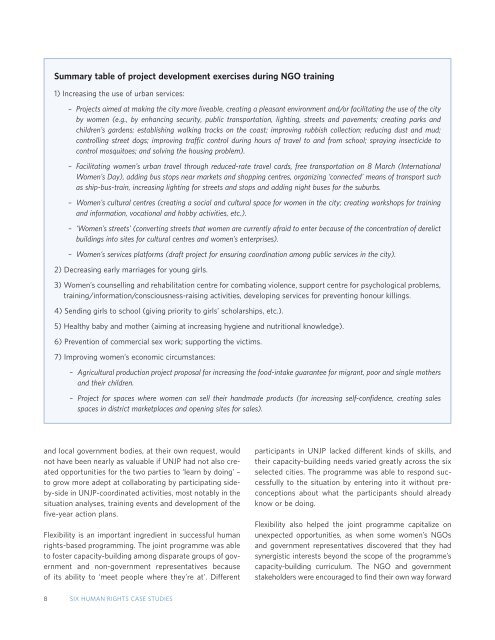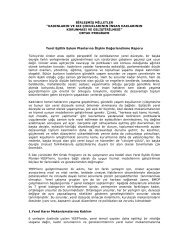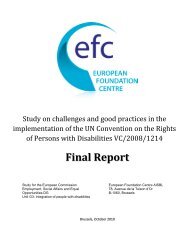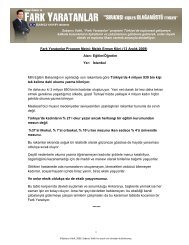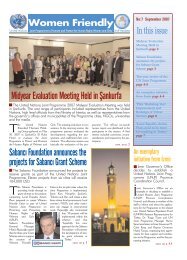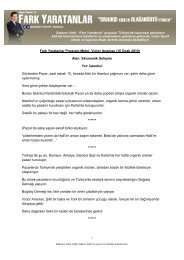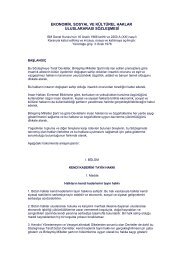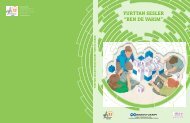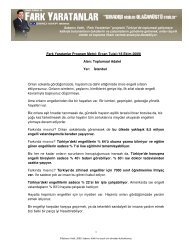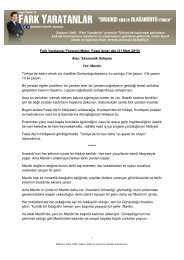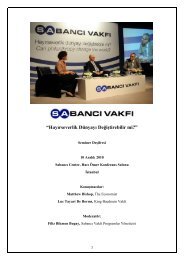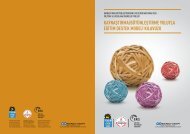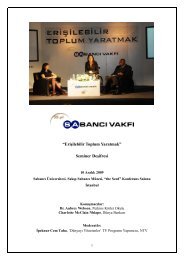children, girls who are not particip<strong>at</strong>ing in the formal educ<strong>at</strong>ionsystem, girls who are forced to marry <strong>at</strong> young ages,women with disabilities, women subjected to domesticviolence, women who cannot use contraceptives for healthreasons and women in polygamous rel<strong>at</strong>ionships.The NGO represent<strong>at</strong>ives spoke about the followinggroups not identified by the government represent<strong>at</strong>ives:women victims of trafficking, sex workers, women whosecultural or social environments contribute to psychologicalproblems, ‘good girls’ who do not go out and arealways in the house, women who do not speak Turkishwell (such as asylum-seekers, refugees, immigrants andinternally displaced women) and women from differentethnic backgrounds.These differences further demonstr<strong>at</strong>e the value of combiningdifferent stakeholders’ perspectives to develop the bestcommunity interventions.Fostering transparency and accountabilityFrom its inception, UNJP has demonstr<strong>at</strong>ed the importanceof accountability and transparency as human rights principlesby making itself accountable to all UNJP partners andstakeholders. This has meant being forthcoming about allplans and activities, as well as taking responsibility for programmeoutcomes. It has also involved communic<strong>at</strong>ingbroadly and in an effective manner. For example, the resultsof opinion polls th<strong>at</strong> helped inform the situ<strong>at</strong>ion analyseswere presented to all UNJP partners for evalu<strong>at</strong>ion, includingparticip<strong>at</strong>ing women’s NGOs. The results were furtherdiscussed in widely publicized stakeholder meetings anddescribed in printed m<strong>at</strong>erials and in documents posted onthe public UNJP website.The website has been a tool for tracking implement<strong>at</strong>ionmore generally, with UNJP coordin<strong>at</strong>ors publishing frequentupd<strong>at</strong>es and supplementary inform<strong>at</strong>ion there. Since manystakeholders outside of government may not have reliableInternet access, UNJP has also published a quarterlynewsletter th<strong>at</strong> is widely distributed in the particip<strong>at</strong>ingcommunities. Women’s NGOs have helped to dissemin<strong>at</strong>einform<strong>at</strong>ion about UNJP developments to their constituencies,and have relayed the concerns and other responses ofconstituents back to the other UNJP partners.PRELIMINARY RESULTS OF THE PROGRAMMEThe joint programme’s activities thus far, even before completionof the five-year local action plans, have led to a dram<strong>at</strong>icshift in the outlook of participants. According to publicofficials, UNJP local facilit<strong>at</strong>ors and NGO represent<strong>at</strong>ives,the programme’s most important short-term consequenceis to bring the issue of gender discrimin<strong>at</strong>ion outinto the open. Moreover, influential local officials havepromised to increase their commitment. For example, theMayor of Van said in an interview, “From now on, our owninterest will increase because, thanks to UNJP, we haveovercome our lack of familiarity and inhibitions regardingwomen’s issues.”It is also notable th<strong>at</strong> in each particip<strong>at</strong>ing city, NGOs haveproposed <strong>at</strong> least one project for increasing women’s useof urban services and one for survivors of violence, andthey are seeking to have those proposals incorpor<strong>at</strong>ed intothe local action plans. A summary of project ideas developedby the NGOs during their training appears in the boxon the next page.Many other preliminary results confirm the value of a humanrights-based approach. Accomplishments described in thiscase study can be summarized as follows:• better understanding on the part of all stakeholders of theidea th<strong>at</strong> all people are entitled to human rights;• gre<strong>at</strong>er local intersectoral cooper<strong>at</strong>ion, including betweenparties th<strong>at</strong> have never before worked closely together(most notably, some government agencies and women’sNGOs);• government bodies more open to learning about women’shuman rights principles and integr<strong>at</strong>ing these principlesinto their activities;• stronger women’s organiz<strong>at</strong>ions th<strong>at</strong> regard themselvesmore as rights-holders and protectors of the rights ofcommunity members than as charities; and• recognition th<strong>at</strong> change comes from within the communitiesand is contextualized to their own circumstances.CONCLUSION: LESSONS LEARNEDIn order to increase women’s cooper<strong>at</strong>ion with governmentinstitutions in Turkey, the capacity of both parties needed tobe enhanced. The joint programme provides a compellingexample of why capacity-building must go beyond providingtraining, equipment and financial support. The skills andresources th<strong>at</strong> the programme brought to women’s NGOsTURKEY7
Summary table of project development exercises during NGO training1) Increasing the use of urban services:– Projects aimed <strong>at</strong> making the city more liveable, cre<strong>at</strong>ing a pleasant environment and/or facilit<strong>at</strong>ing the use of the cityby women (e.g., by enhancing security, public transport<strong>at</strong>ion, lighting, streets and pavements; cre<strong>at</strong>ing parks andchildren’s gardens; establishing walking tracks on the coast; improving rubbish collection; reducing dust and mud;controlling street dogs; improving traffic control during hours of travel to and from school; spraying insecticide tocontrol mosquitoes; and solving the housing problem).– Facilit<strong>at</strong>ing women’s urban travel through reduced-r<strong>at</strong>e travel cards, free transport<strong>at</strong>ion on 8 March (Intern<strong>at</strong>ionalWomen’s Day), adding bus stops near markets and shopping centres, organizing ‘connected' means of transport suchas ship-bus-train, increasing lighting for streets and stops and adding night buses for the suburbs.– Women’s cultural centres (cre<strong>at</strong>ing a social and cultural space for women in the city; cre<strong>at</strong>ing workshops for trainingand inform<strong>at</strong>ion, voc<strong>at</strong>ional and hobby activities, etc.).– ‘Women’s streets’ (converting streets th<strong>at</strong> women are currently afraid to enter because of the concentr<strong>at</strong>ion of derelictbuildings into sites for cultural centres and women’s enterprises).– Women’s services pl<strong>at</strong>forms (draft project for ensuring coordin<strong>at</strong>ion among public services in the city).2) Decreasing early marriages for young girls.3) Women’s counselling and rehabilit<strong>at</strong>ion centre for comb<strong>at</strong>ing violence, support centre for psychological problems,training/inform<strong>at</strong>ion/consciousness-raising activities, developing services for preventing honour killings.4) Sending girls to school (giving priority to girls’ scholarships, etc.).5) Healthy baby and mother (aiming <strong>at</strong> increasing hygiene and nutritional knowledge).6) Prevention of commercial sex work; supporting the victims.7) Improving women’s economic circumstances:– Agricultural production project proposal for increasing the food-intake guarantee for migrant, poor and single mothersand their children.– Project for spaces where women can sell their handmade products (for increasing self-confidence, cre<strong>at</strong>ing salesspaces in district marketplaces and opening sites for sales).and local government bodies, <strong>at</strong> their own request, wouldnot have been nearly as valuable if UNJP had not also cre<strong>at</strong>edopportunities for the two parties to ‘learn by doing’ –to grow more adept <strong>at</strong> collabor<strong>at</strong>ing by particip<strong>at</strong>ing sideby-sidein UNJP-coordin<strong>at</strong>ed activities, most notably in thesitu<strong>at</strong>ion analyses, training events and development of thefive-year action plans.Flexibility is an important ingredient in successful humanrights-based programming. The joint programme was ableto foster capacity-building among dispar<strong>at</strong>e groups of governmentand non-government represent<strong>at</strong>ives becauseof its ability to ‘meet people where they’re <strong>at</strong>’. Differentparticipants in UNJP lacked different kinds of skills, andtheir capacity-building needs varied gre<strong>at</strong>ly across the sixselected cities. The programme was able to respond successfullyto the situ<strong>at</strong>ion by entering into it without preconceptionsabout wh<strong>at</strong> the participants should alreadyknow or be doing.Flexibility also helped the joint programme capitalize onunexpected opportunities, as when some women’s NGOsand government represent<strong>at</strong>ives discovered th<strong>at</strong> they hadsynergistic interests beyond the scope of the programme’scapacity-building curriculum. The NGO and governmentstakeholders were encouraged to find their own way forward8SIX HUMAN RIGHTS CASE STUDIES


